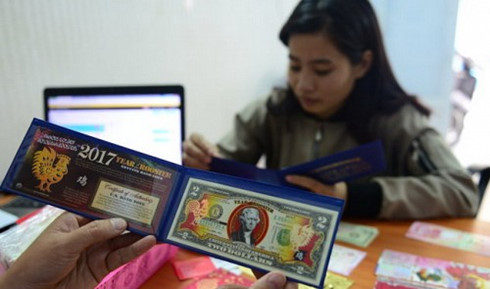Vietnamese hunt for new, unique banknotes before for New Year lucky money
Traditionally the most festive and awaited holiday season in Vietnam, Tet, or Lunar New Year, is also a time when many customs encompassing the shared values of its people are practiced, including ‘li xi,’ or the giving of lucky money.
On the first day of the Lunar New Year, this year falling on January 28, children line up to recite New Year wishes to their parents and grandparents.
In return they are given brand-new banknotes, usually of small face value, in a red envelope, symbolizing good luck and the power to ward off evil spirits.
The lucky money is also given to elders in the family as a way of wishing them longevity and health for the rest of the year.
With Tet just around the corner, many locals have already begun their hunt for new and unique banknotes to be used as lucky money.
Earlier this month, the State Bank of Vietnam announced that no new banknotes with face values of VND5,000 (US$0.22) or less will be printed for Tet, giving rise to many online money exchange services.
On one Facebook page, new banknotes available in all face values are offered in exchange for a ‘fee’ of 15 percent of their value. Those that exchange more than VND1 million worth of banknotes enjoy a more favorable commission rate of ten percent.
 |
To exchange for Vietnam’s 500-dong notes, the second lowest value note among those still in circulation, a buyer must pay a 120% fee.
Commemorative banknotes which were issued on the 65th anniversary of the State bank of Vietnam are also hunted for prices between two and three times their original costs.
Apart from local currency bills, unique banknotes such as Maldivian bills and fake dollars featuring imprinted roosters, the upcoming lunar year’s zodiac animal, are also being sought after by Vietnamese collectors.
Maldivian rufiyaa banknotes, which feature a departing sailboat, are believed to signify a year of ‘smooth sailing’.
Each of these special banknotes, including the fakes, are sold at five to ten times their face values.
According to Nguyen Hoang Minh, deputy director of the Ho Chi Minh City branch of the State Bank of Vietnam, the act of exchanging old banknotes for new ones at a profit is against Vietnamese law.
“The people’s demand for new banknotes is understandable, but it is not an essential task for banks,” Minh explained. “The number of newly printed banknotes is limited compared to the huge demand.”

